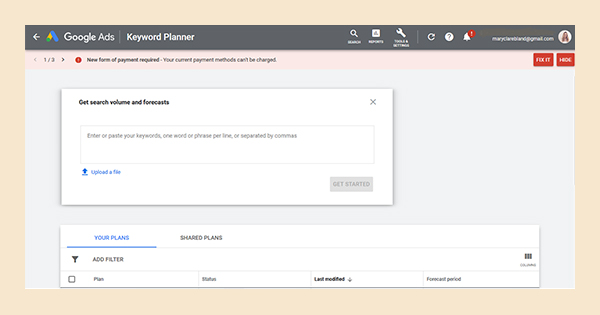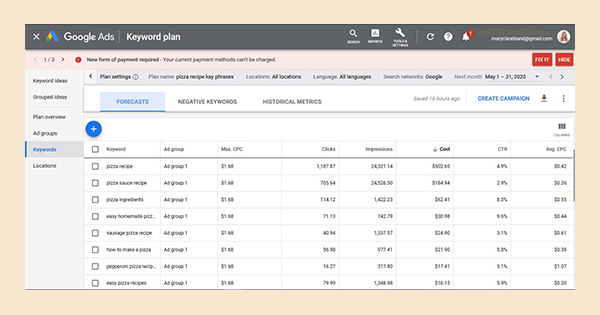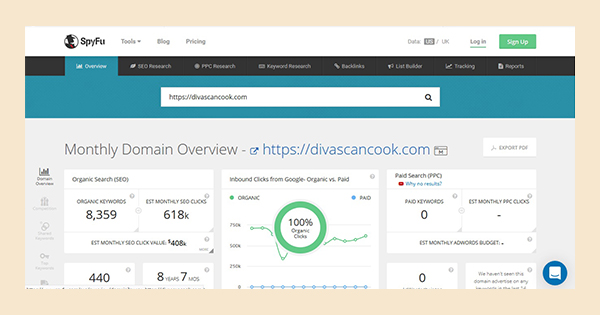M3- Key Phrase Research
What you will learn: What key phrases are, the different types of key phrases, the trade off between impressions and conversions and the metrics you should look at when determining which key phrases to use in your SEO.
Tasks (2): You will compile a list of key phrases, and their estimated impressions and click through rates, to use in your SEO. Then you will submit your key phrase list to Mary Clare for review and suggestions.
Talk: When you finish your key phrase research, schedule a talk with Mary Clare to discuss your results. As some people find this module difficult, if you hit a roadblock, feel free to schedule the talk before you finish your key phrase research.
Tools: Google Keyword Planner & Spyfu
Read Time: 15 minutes
Task Time: 2-3 hours for your key phrase research, depending upon how much competition there is for your business
What is a key phrase?
A key phrase is the group of words you type into a browser search bar to find information. For example, if you want to make a pizza, you may type “best pizza recipe” as your search query. Thus, “best pizza recipe” is your key phrase.
Back in the day, people would type single words as search queries. Those were referred to as keywords. As search engines have evolved and internet content has increased exponentially, people now type multiple words as search queries. Keep in mind: the two terms are often used interchangeably, even by Google.
The three types of key phrases
If you search on “types of key phrases,” you will get search engine result pages (SERPS) telling you there are up to 18 types of key phrases. To keep things simple, we are going to focus on three:
‣ Head terms
‣ Middle tail key phrases
‣ Long tail key phrases.

Head terms are shorter key phrases that are more generic in nature. For example, if you are trying to find a pizza recipe, the words “pizza recipe” is a head term. Head terms are one or two words.
Middle tail key phrases are more descriptive in nature. Using our pizza example, the words “cheese pizza recipe” or “best cheese pizza recipe” are middle tail key phrases. Middle tail key phrases are three to five words long.
Long tail key phrases are very specific in nature. Again using our pizza example, the words “four cheese and sausage pizza recipe” is a long tail key phrase. Long tail key phrases are five or more words long.
Which is better: head terms, middle or long tail key phrases?
None of them. Head terms might seem better because you can reach more users. However, this also means that they are much harder to rank highly in SERPS because the competition is so fierce. You can see this by typing “pizza recipe” into a browser search box. Depending upon your location, you will see different results because, if you recall from Module 1, Google Ranking System’s algorithms take into account your context and settings. For example, I am based in Spain but I have my browser settings configured to display everything in English. In this case, the top results are from the BBC, Jamie Oliver and other big brands. If I switch my VPN so my IP address is in New York, the top search results are from Bon Appetit and Allrecipes- again, both big sites.
However, when I use “best cheese pizza recipe” as my search query, a few smaller brands start to appear in the search results. When I type “four cheese and sausage pizza recipe” as my search query, more smaller brands appear. Note: keep in mind that for this particular query, all of the search engine results on the first page are from brands that invest a lot of time and money in their SEO and paid search campaigns.
The above demonstrates what is almost always true in marketing: it is always easier to find a niche and market to that. Many small business owners are afraid to be too specialized for fear of losing customers. But the truth is, there is less competition in smaller markets. Plus, people will be more inclined to click on your search result if they are looking for something specific and the text in your search result meets their needs. This is illustrated in the following graphic:

To put it simply, there is a trade-off between the search volume of a key phrase and how likely that key phrase is to convert (meaning someone clicks on your Google search result).
Local Search
If you have a business whose clientele is in a specific area (city, county, borough, parish, etc.) your SEO will likely be much easier. For example, if you teach martial arts classes, the key phrase “martial arts classes” has a top bid of $3.82. However, the top bid for the key phrase “martial arts classes in Lewes” has so little competition that there is no data available. If you want to open a martial arts school in Lewes, UK, this means you can jump to the top of the search rankings with very little effort.
However, the opposite is true in very competitive markets. For example, the key phrase “martial arts classes in NYC” has a top bid of $6.25. The more competitive your market, the more you will need to make use of Google Keyword Planner.

If you are a local business in a small, less competitive market, make sure you use your location in all of your key phrases.
Summary
We also want to keep in mind that SEO is a marathon: not a sprint. So you don’t want to rule out using head terms completely because if you are persistent in your SEO, you eventually will be able to rank for a head term as your site generates more page views.
What’s the upshot? Use a combination of head terms, medium and long tail key phrases. This Basic SEO course is about on-page SEO, which is the SEO on your web pages- not your blog posts, events or portfolio pages. When you select your key phrases for your pages, we recommend using head terms in a quarter to a third of your pages and using medium and long tail key phrases on the rest. Although “a quarter to a third” sounds vague, you need to keep in mind that SEO is as much of an art as a science. In this situation, we will use the head terms for branding purposes, not just to get your site ranking highly (more on this in Module 4- On-Page SEO). Finally, if you are a local business in a less competitive market, make sure to use your location in your key phrases.
An interesting side note
Going back to our “pizza recipe” search query, I then turned off my VPN and did my search query in Spanish. The search results in this situation were quite different: many smaller brands showed in the top 10 search results. This is because Spain, and Spanish speaking countries in general, are far behind the English market in terms of SEO. So again, this is where the art of SEO comes in: if your site is in a language or market where SEO is not up to international standards, you may be able to rank using head terms very quickly.
How to do key phrase research
Google’s goal is that a user’s search intent is satisfied. This means that when a user types in a key phrase, Google wants them to find what they are looking for right away. A search intent could be:
‣ To learn something
‣ To go somewhere
‣ To do something
‣ To buy something
‣ To get something for free
When you create key phrase lists, you want to try and get inside the heads of your potential customers. You want to figure out the key phrases they will use to find your product or service. This is why we created buyer personas- the more you understand and empathize with your customers, the better able you will be to forecast their search queries.

Task 1: Build key phrase lists
Step 1
Pretend you are the buyer persona whose buying behavior accounts for the biggest share of your revenue. Sit down and brainstorm the key phrases this fictional character would use to find your website. Remember: Stay in character! Put these key phrases into a spreadsheet in Column A.
Highlight them in pink (or whatever color cheers you up). Note: you must name the column “keyword.” This is important for Keyword Planner.
Step 2
Your next step is to get someone else to make a list of key phrases that they would use to find your product or service. Ideally, ask a friend or family member that matches your buyer persona to write down a list of key phrases they would use to find your website. If you don’t have a friend or family member that can help, ask one of your customers. You can always give them a little freebie if you feel uncomfortable doing this.
When you have their list of key phrases, put them in your spreadsheet in a second color (I used green). Then, cross reference them with your list. Any key phrase that appears on both lists is a strong candidate. Highlight those cells in a third color (I used blue). Note: I have used a limited number of key phrases to make this example easier to follow.

Step 3
Go to Google and type the key phrases in the first highlighted cell into Google’s search bar. Now, scroll to the bottom of the page. You will likely see a number of suggestions from Google. These are key phrases that people who search on your key phrase also use.
If you don’t see a list of key phrases, this means the key phrase you entered does not have a lot of search volume. If this happens for a lot of your key phrases, don’t be alarmed. It means you have a very niche business and will be able to rank in the top search results relatively quickly.

Go through these and enter them into your spreadsheet. I like to enter them under each blue phrase, like this:

Repeat this process for all your highlighted key phrases. If you have a great deal of highlighted key phrases, I recommend just doing five to get started. You can do more, later, if you start blogging extensively. I only used one to make the examples easier to follow.
When you are finished, click on “Save as” and save your file as a .cvs file.
Step 4
Tool: Google Keyword Planner
Now we are going to learn more about these key phrases and try to narrow the field.
Click on the above link to Google Keyword Planner. You will have to create an Adwords account and a Gmail account if you don’t already have them.
It can be a little tricky to access Keyword Planner for free if you have never run an Adwords campaign. If you need help, here is a guide I created to walk you through the process: How to access Google Keyword Planner for free
After you create your account, click on the box on the right: Get search volume and forecasts.

Next, click on “upload a file.” Upload the .cvs file you created in Step 3. Note: cell A1 MUST contain keyword and nothing else.
After you upload the file, click on “keywords” from the screen that looks like this:

You will be taken to a screen that looks like this:

Although this is aimed at people that want to use Google Adwords, it still gives us some very useful information for SEO purposes. We want to focus on the following columns:
1– Keyword
2– Impressions: This is number of times Google estimates your search result from that keyword will be seen, if it ranks on the first page. It may take it some time to rank on the front page via SEO, whereas if you pay enough with Adwords, it will rank on the front page very quickly. However, the good thing about SEO is that any work you do doesn’t go away in time- the results typically improve with time. This is one reason it is so much better than paid search. If you stop a Google Adwords campaign, you basically lose everything. Finally, notice that head key phrases and middle tail key phrases have higher numbers of impressions.
3– CTR: This the estimated ratio of users who click on the search result from the key phrase to the number of total users who view that result. This is really important because it measures how likely this key phrase is to convert (meaning people actually go to your website when they see the key phrase’s search result). Although there are some notable exceptions, the inverse relationship between impression and conversions that we discussed above generally holds true.
3– Avg. CPC: This is the estimated cost per click for that key phrase if you run a Google Adwords campaign. It is a measure of how hard it will be for you to rank on the first page of Google search results for that key phrase when you do your SEO. The higher the number, the harder it will be to rank.
Ideally, what you are looking for are key phrases with a relatively high number of impressions for a relatively low CPC. This list of key phrases has a perfect example: the key phrases “pizza recipe” and “pizza sauce recipe.” “Pizza sauce recipe has an estimated 24,526 impressions which is a little more than “pizza recipe,” which has an estimated 24,321 impressions. However, the key phrase “pizza sauce recipe” is almost half the price: $0.26 CPC versus $0.42 for “pizza recipe.” These are the types of discrepancies you need to look for and exploit when you choose the key phrases for your website pages.

Step 5
It is always helpful to look at what your competition is doing. It’s important to see how much they are focusing on SEO and which key phrases are working for them.
Tool: Spyfu
Click on the above link to Spyfu. Type in your competitors’ domain names and you will see a wealth of information.
The first thing to look at is their estimated monthly SEO click value, which appears on the left. In the following example, extending our pizza key phrase research, I looked at one of the smaller contenders. I used the Google search results from the key phrase “easy pizza recipe” and investigated the last domain that appears in the first page of the search results: divascancook.com. They are spending an estimated $408k on SEO, per month. Note: this number is an estimate of what it would pay an agency to do the SEO, so for some smaller or middle market businesses it may not be accurate on a monetary basis. However, over the years I have found it is a very good proxy for the amount of time and effort people are spending on SEO if they are doing it themselves.

Before you get too overwhelmed, I want to point out that this is quite a lot of time/money to spend on SEO. If your competitors are at this level, you will need to focus on very niche, long tail key phrases to get ranked on the first page.
However, especially if you are a local business, your situation probably looks something more like this:

I searched on “Minnesota wedding photographer.” Although a few big sites came up, such as The Knot, this small photographer still made the first page of the search results. Spyfu says she is spending $5.77k on SEO. However, as I mentioned, this is estimated using big agency prices. A quick look at this photographer’s website tells me she is only blogging about once per month. However, she is doing everything right: writing long articles, focusing on trending topics and her site is internally well optimized.
Note
If you are a very local business, you might be able to rank on the first page just by completing this course. However, if you are in a more competitive industry, you will likely need to take our Level Up your SEO and Take Our SEO to a Higher Level. These will help you create a blogging strategy and learn to build backlinks. However, it is all within your grasp if you are willing to invest a few days a month, for the next 6-12 months, to grow your business. So don’t let the above numbers scare you. You can do it!
If you are in the opposite situation: you don’t see much search volume (or maybe no search volume at all), you are actually lucky. It will be very easy to rank on the fist page of SERPS.
Step 6
If you scroll down the first page of Spyfu, you will see this domain’s other key competitors and the top key phrases they rank for.
The Top Keywords section is valuable for our key phrase research. Click on “View all organic keywords”:

And you will be taken to this page:

Although many of the key phrases are behind a paywall, Spyfu is not particularly expensive when it comes to paid SEO tools. If you have strong competition, I think it is worth the $39 to get a monthly membership. That is all it will take to build your key phrase list, which you can use for a year or two. It also has a number of other tools that are useful if you take our more advanced SEO courses.
If you invest in a Spyfu membership, or see competitor’s key phrases on the free version that you think are useful, put those in your key phrase list. Make sure to include the number of impressions, CTR and average CPC from Google Keyword Planner.
Once you finish your list, create a new one for each buyer persona you have.
Save these lists as you will need them for future modules and courses.
It is important to note that I do not receive any commissions or other compensation from Spyfy. I just think it is one of the best SEO tools on the market and use it extensively myself.

Task 2: Submit your key phrase list to Mary Clare for review and suggestions. It can be in an Excel workbook, or a Google Sheet. If you submit it in Excel, please submit as a .xls file, not a .cvs file.
Takeaways
- There is a trade off between using head term, middle tail and long tail key phrases.
- Typically, you will want to use a combination of the three. Head terms will help with branding when you create your SEO titles and meta descriptions in future modules. Middle and long tail key phrases will help you rank in search engine result pages.
- The more competitive your industry, in terms of SEO, the more you will need to focus on niche, long tail key phrases.
- If you have a local business, make sure to use your location in your key phrases.
- You should now have a list of key phrases that you can use both to optimize your current site for search and to create future content.
- You have two excellent tools that you should bookmark for future use: Google’s Keyword Planner and Spyfu.
FAQS
Q1: The person I chose to make a key phrase list didn’t write a single key phrase that I did. What do I do?
A1: Use both sets of key phrases in your spreadsheet and see what Keyword Planner recommends.
Q2: When I put my key phrases into Keyword Planner, there is very little data on any of them. What do I do?
A2: First, keep in mind that this is a very good thing! It means the competition for your key phrases is very low and it will be easy to rank relatively quickly. If this happens, type what you think are your best key phrases (start with the ones that appeared on both your list and your helper’s list) into Google and look at the SERPS. Those that yield results that you think your buyer personas are likely to click on are the ones you should focus on.


